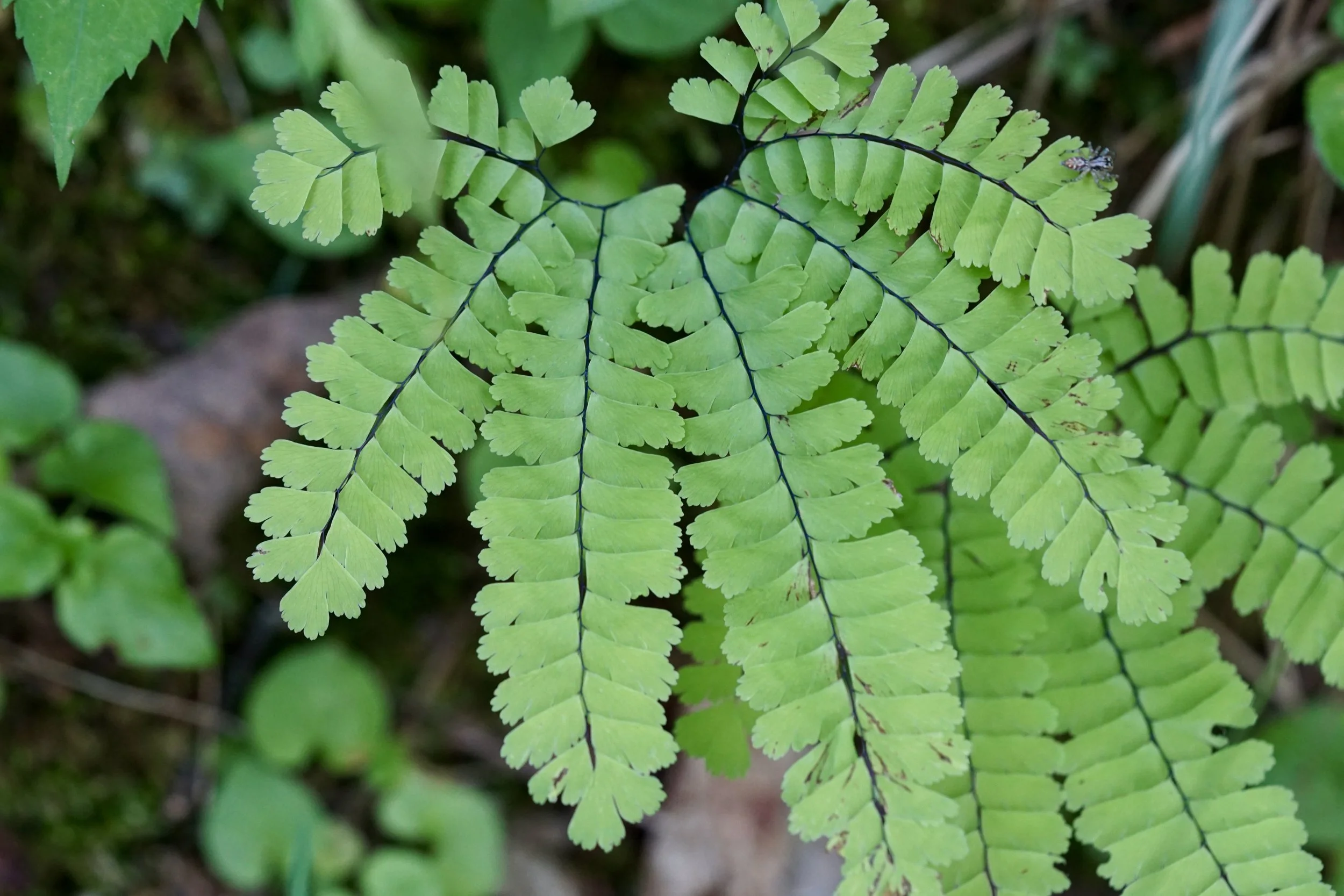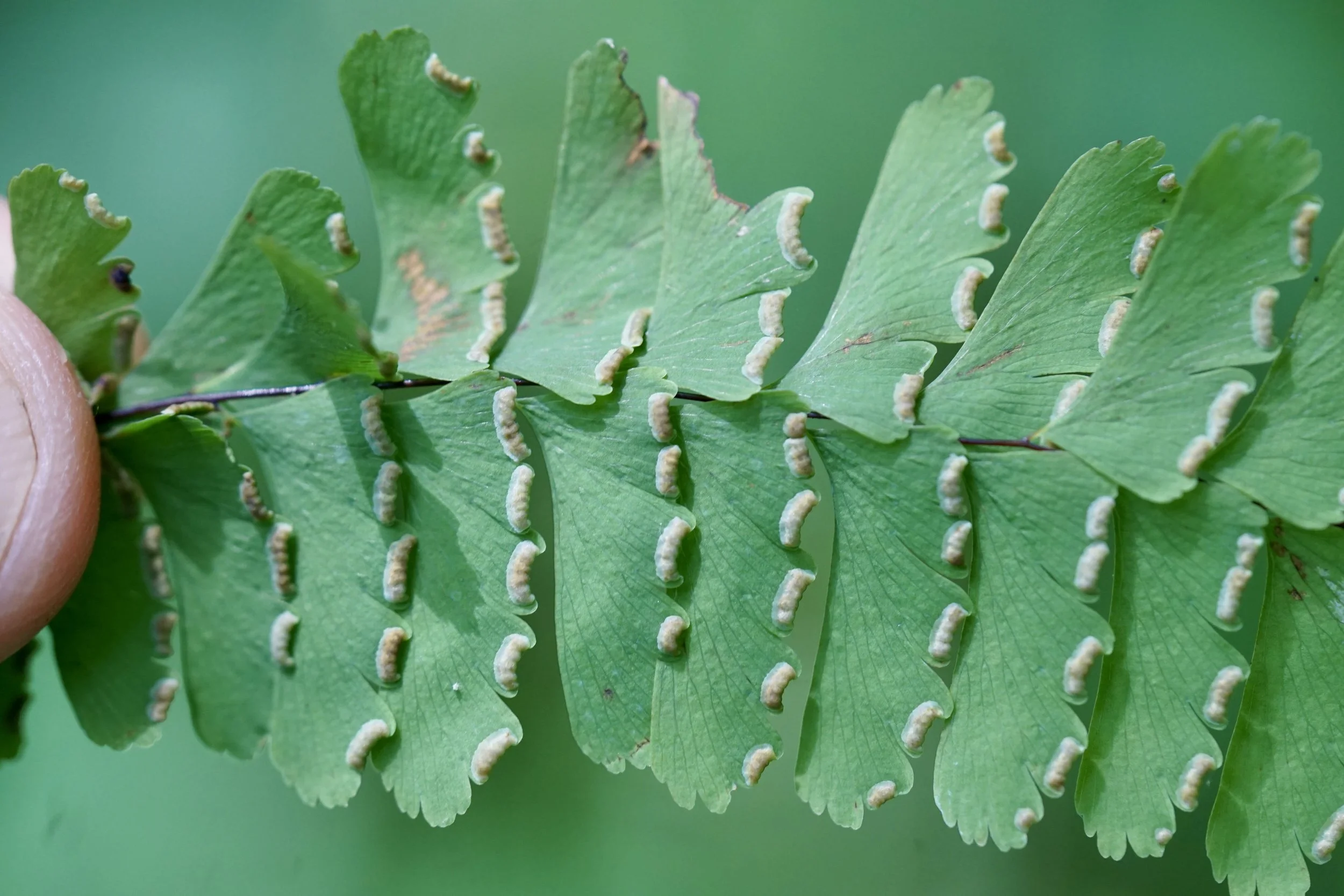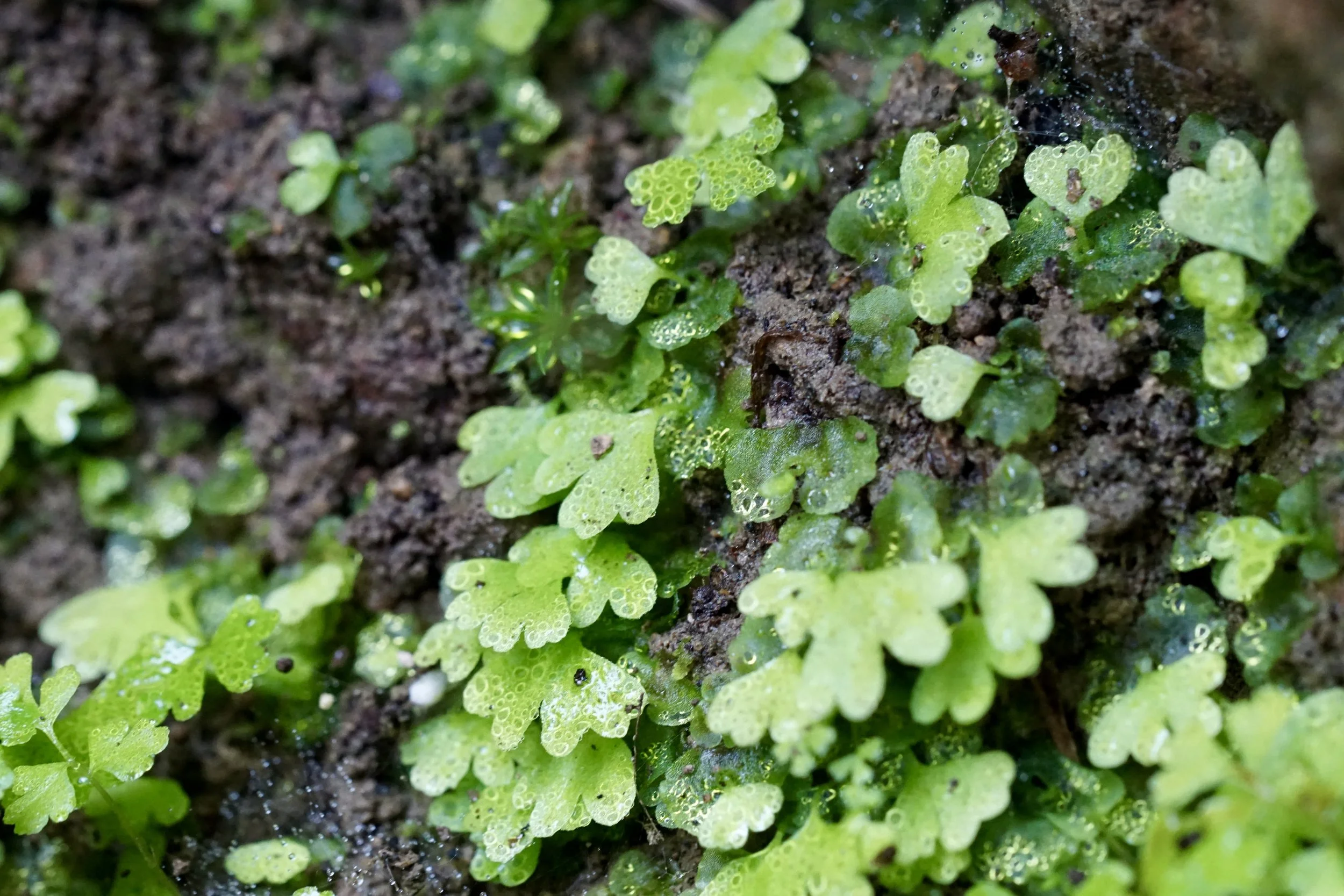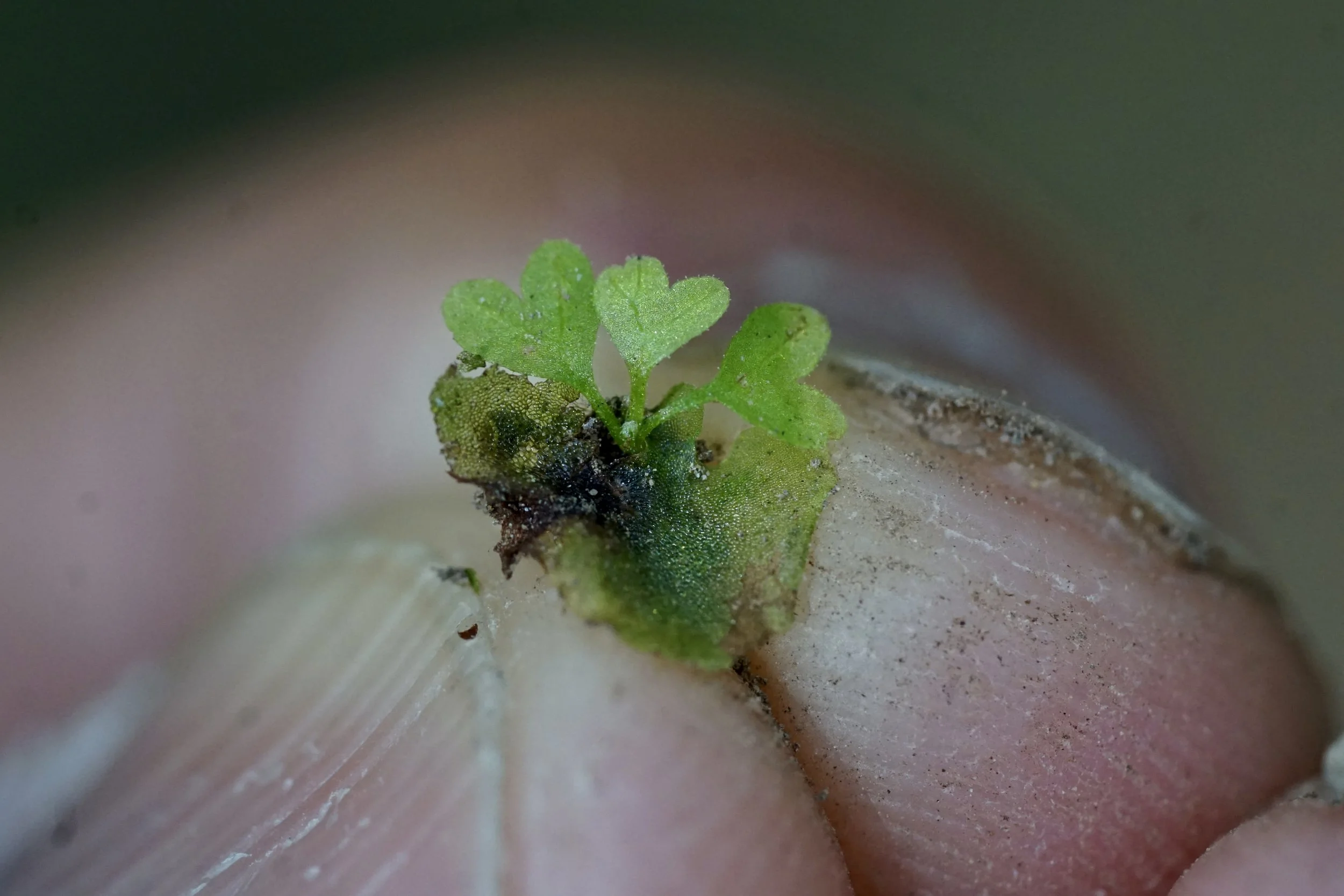A weak link, or strong linchpin?
Perhaps the most damning accusation we bestow upon ferns is the same that we direct at marsupials: the way they reproduce is inferior.
Ferns, of course, lack flowers and fruits, they reproduce by freely dispersing spores. The plant you walk past in the woods with large feather-like fronds is called the sporophyte—the spore producing part of the fern life cycle. The sporophyte is diploid meaning it has two sets of chromosomes, one from mom and one from dad, just like us.
Frond of the maiden hair fern (Adiantum pedatum). The fern we commonly pass in the woods is a sporophyte.
If you flip over a leaf of one of these plants you will see small dots or lines peppering the underbelly of the frond. These dots, sori (sorus if singular), are composed of multiple individual sporangia or spore houses. Within a single sporangium, cells undergo meiosis, whereby a single cell with two copies of chromosomes will divide twice to create four individual cells, each with half of the genetic material. These meiotic products are the spores. This is a bit confusing to us because it is fundamentally different from how we do things. When we do meiosis the final products are sperm or egg cells. However, in plants, the products of meiosis are spores.
At maturity the fern will release its spores into the wind. Most of these won’t make it to favorable habitats and never see the light of day. But, occasionally one will find a suitable home. Just like a seed, the spore will germinate. Unlike a seed, the germinated spore does not produce a whole new fern-plant like the one it came from, but will develop into a full second life stage that is fundamentally distinct from the large ferny sporophyte. This new plant is called the gametophyte. While very different biologically, you can think of this like the larval stage of a fly.
Underside of a Adiantum pedatum frond showing the individual sori clustered along the leaf margins.
The gametophyte germinates from the spore, one equal cell division at a time. It grows until it reaches about the size of your pinky nail. Many of these gametophytes are small, green, and flat, making them hard to find growing in soil crevices or embankments. But if you do find them, they are a sight to behold—emerald jewels hidden in the brown soil. The gametophyte is the sexual stage of the fern life cycle. At maturity, it produces egg cells and sperm cells with flagella (just like ours) which will fuse during fertilization to produce the next generation of fern sporophytes. Because the sperm are flagellate and have to find the egg on another gametophyte, they often require a thin film of water to swim along.
In plants with seeds (pine trees and flowering plants), all of these processes still occur, but they are wrapped up inside the seeds and fruits, protected from the outside world. The evolution of the seed is often discussed as a more sophisticated reproductive adaptation, superior to that of the fern. No doubt, the seed and flower were important innovations that have facilitated many unique evolutionary outcomes for the seed plants. However, the origin of the seed does not relegate the fern life cycle to the evolutionary sidelines. It does not make them weak or inferior.
I am a pteridologist (fern biologist), and I recognize my biases—screaming from the top of the building about my study system. But this is not simply a pedantic and self-indulgent argument. The narrative of the simple and weak fern has tangible effects on how we rank organisms in the polity of nature, which have downstream consequences for how we teach about evolution, how we conduct research, and ultimately how we think about the world. Indeed, if we put ferns on a ladder rung lower than the flower, how do we then treat other species relative to ourselves?
Aspects of the fern life cycle are often downplayed, misinterpreted, or misconstrued; here, I will highlight several points about fern reproduction to explain why they may not be so weak after all.
Fern gametophytes peppering a soil bank. Small single-leaved sporophytes emerging post-fertilization.
The first downplayed aspect of fern reproduction is their sexual nature. In most textbooks ferns are depicted as having a single gametophyte that produces both sperm and egg. In the small diagrams of these life cycles, egg and sperm from the same individual gametophyte will fuse. This is an issue, and as Pitterman and colleagues put it a “nonsensical textbook [depiction] of the selfing fern gametophyte.” If this occurred, it would mean that the new diploid organism would be 100% identical at every single point in the genome—no genetic diversity whatsoever. Imagine the effects of inbreeding with a sibling, but even worse.
However, as Haufler and colleagues pointed out in 2016, this intense level of inbreeding does not happen very often. While ferns may be able to self-fertilize, most species are outcrossing, meaning they need two individual gametophytes growing side by side, sperm from one needs to fuse with an egg from another. What’s more, many ferns have actually evolved sophisticated mechanisms to chemically castrate their neighbors to ensure this process of outcrossing.
If a fern spore lands in an environment and germinates without any neighboring relatives, it will just about always become female and produce an egg. This female gametophyte then starts to secrete chemicals called antheridiogens (of Greek etymological origin meaning the creator of a sperm producer). If another spore of the same species lands next to this established gametophyte, the antheridiogen chemicals will change the development of the new gametophyte making it exclusively male. This complex chemical mechanism helps ensure ferns do not inbreed. This process is analogous to many mating systems in flowering plants. For instance, some flowers are protandrous, meaning pollen is mature before ovules; other plants have evolved to be dioecious, producing fully separate pollen producing and seed producing individuals.
Fern gametophyte with young sporophyte emerging.
The second misinterpreted component of the fern life cycle is the hardiness of the gametophytic stage itself. This stage of the fern life cycle is often viewed as the weak link. Of course they are! These small plants that are no bigger than your thumb nail must be the weak stage compared to the large pompous sporophyte plant you see lavishly waving its fronds in the woods. But the reality is that the fern gametophyte is robust, in many cases more robust than the sporophyte.
The unit of dispersal of ferns is the haploid spore, which may be dispersed to spaces beyond the physiological range of their current sporophyte. If the gametophyte germinates in a new terrain it must withstand new stresses—for at least part of the year. The gametophytes, then, are more like mini satellites of the life cycle, explorers of new spaces and climate.
One in a million spores may have the right mutation that allows them to survive in an ecosystem a bit dryer, colder, wetter, or hotter than its parent’s range. This is born out in the beautiful physiological work on drought tolerance of fern gametophytes by my colleague and friend James “Eddie” Watkins, Professor at Colgate University. In his pioneering studies he found that, in many cases, the fern gametophyte is more drought tolerant than its sporophytic counterpart. Eddie has been sampling gametophyte physiology for 20 years and has observed that most gametophytes can dry down almost entirely and retain the ability to recover. This cannot be said for the overwhelming majority of large sporophytes. The gametophyte, thus, can be viewed as the linchpin of the fern lifecycle, not the weak link. It is an important stage that acts as the main explorer of new ecosystems.
The third underappreciated aspect of fern reproduction is how selection can act directly on individual genes in a multicellular haploid stage. Since the fern gametophyte is haploid, it only has a single copy of each gene. Single genes are expressed and interact with their environment, unshielded by the other gene copy of its diploid counterpart. This means that natural selection will immediately “see” any genes that are expressed during the early life stages. If deleterious or “bad” genes are expressed in the early gametophytic stage they are more likely to be culled from the population. This is counter to what occurs in the seed and flowering plants. Seed plants also have multicellular gametophyte phases, but they are tightly wrapped up in the seed coat or pollen grain wall, protected, nourished, and so inexorably linked to the diploid parent that they are not as exposed to the environment—especially compared to fern gametophytes. Thus each expressed gene in seed plants may not be subject to as strong of a selection pressure from the outward environment.
Finally, to relate ferns to another group of animals often seen as a weak link, I want to analogize the fern gametophyte to the larval stage of flies (Diptera) and other holometabolous insects— those that undergo a complete metamorphosis. One point I have not yet emphasized is the separation of the gametophyte and sporophyte life stages of the fern. Both of these life stages can grow as independent entities with different functions. The large fern in the woods is an independent plant responsible for spore production. The smaller gametophyte is also an independent plant responsible for sex. Each life stage has its individual function. Similarly larvae of insects, while not haploid like gametophytes, represent a distinct life stage that to us often seem weaker than the adult stage. Like gametophytes and sporophytes, larvae and adults also have a division of labor separated into two entities; often larvae eat and adults reproduce. In an organism where all the processes of life are integrated into a single entity, selection cannot act on individual processes to optimize single functions, there is often a tradeoff. However, while inexorably linked to their other life stages, gametophytes and larvae are both free-living organisms and subject to the forces of evolution and selection acting directly on these life stages for their specific purpose. This allows for the division of labor between growth and reproduction according to life stage. Each phase is not worse or better, but can be independently crafted by natural selection and other evolutionary processes.
Ferns have been around for over 400 million years with a relatively unchanged reproductive cycle. They lack flowers, fruits, and seeds not because they didn't make it in evolution, but because their reproductive modes worked just fine for them. Interestingly, based on the fossil record, ferns did produce seeds once upon a time, but that lineage went extinct—who needs seeds anyway? We often view smaller and seemingly simpler organisms or parts of life cycles as weaker or the bottleneck of an organism. This leans into our general biases of evolution as progressive and of fitness as meaning size and strength. But larvae and gametophytes, as weak as they may seem, are equal products of evolution and natural selection as their larger other halves.
October 1, 2025
References and further readings
Haufler, Christopher H., et al. "Sex and the single gametophyte: Revising the homosporous vascular plant life cycle in light of contemporary research." BioScience 66.11 (2016): 928-937.
Hornych, Ondřej, et al. "Insights into the evolutionary history and widespread occurrence of antheridiogen systems in ferns." New Phytologist 229.1 (2021): 607-619.
Pittermann, Jarmila, et al., "The physiological resilience of fern sporophytes and gametophytes: advances in water relations offer new insights into an old lineage." Frontiers in Plant Science 4 (2013)
Sessa, Emily B., et al., "On the widespread capacity for, and functional significance of, extreme inbreeding in ferns." New Phytologist 211.3 (2016): 1108-1119.
Watkins, James E., et al. "Ecological and evolutionary consequences of desiccation tolerance in tropical fern gametophytes." New Phytologist 176.3 (2007): 708-717.
Yang, Andrew S. "Modularity, evolvability, and adaptive radiations: a comparison of the hemi‐and holometabolous insects." Evolution & development 3.2 (2001): 59-72.





